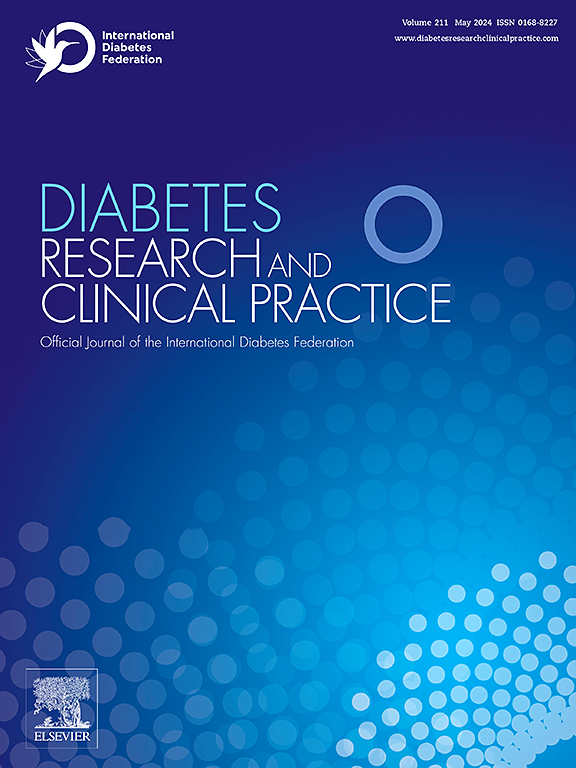Global, regional, and national burden of type 2 diabetes mellitus attributable to particulate matter pollution from 1990 to 2021: An analysis of the global burden of disease study 2021
IF 6.1
3区 医学
Q1 ENDOCRINOLOGY & METABOLISM
引用次数: 0
Abstract
Aims
The study uses GBD 2021 data to measure the type 2 diabetes mellitus (T2DM) burden linked to particulate matter pollution (PM2.5) exposure, highlighting environmental factors as rising contributors to the disease.
Methods
We used advanced methods like Joinpoint regression and decomposition analysis to track PM2.5 exposure’s effects on T2DM, analyzing its burden by Socio-demographic indices (SDI) to find high-risk areas for targeted interventions.
Results
In 2021, the global burden of T2DM attributable to PM2.5 exposure reached 12,904,493 DALYs, a substantial increase from 1990. The age-standardized mortality rates (ASMR) and age-standardized death rates (ASDR) showed an upward trend, with males exhibiting a higher disease burden than females. The burden was highest in lower SDI quintiles, with faster growth rates in ASDR and ASMR compared to higher SDI regions. The population attributable fractions (PAFs) for ASDR and ASMR due to PM2.5 were 17.07 % and 17.47 %, respectively, with higher PAFs in lower SDI regions.
Conclusion
Our results show that air pollution significantly affects global T2DM rates, necessitating policies to lower PM2.5 and boost health system resilience. Ongoing monitoring and research are key to crafting strategies against pollution’s health effects.
1990 年至 2021 年颗粒物污染对全球、地区和国家造成的 2 型糖尿病负担:2021 年全球疾病负担研究分析》。
目的:该研究利用《2021 年全球环境与发展报告》(GBD 2021)中的数据来衡量与颗粒物污染(PM2.5)暴露相关的 2 型糖尿病(T2DM)负担,强调环境因素是导致该疾病的重要因素:方法:我们采用了联结点回归和分解分析等先进方法来追踪 PM2.5 暴露对 T2DM 的影响,并通过社会人口指数(SDI)分析其负担,从而找到需要采取针对性干预措施的高风险地区:结果:2021 年,PM2.5 暴露造成的 T2DM 全球负担达到 12,904,493 DALYs,比 1990 年大幅增加。年龄标准化死亡率(ASMR)和年龄标准化死亡率(ASDR)呈上升趋势,男性的疾病负担高于女性。与 SDI 值较高的地区相比,SDI 值较低的五分之一地区的疾病负担最高,年龄标准化死亡率和年龄标准化死亡率的增长率较快。PM2.5导致的ASDR和ASMR的人口可归因分数(PAFs)分别为17.07%和17.47%,SDI较低地区的PAFs更高:我们的研究结果表明,空气污染严重影响了全球 T2DM 的发病率,因此有必要制定政策降低 PM2.5,提高卫生系统的适应能力。持续的监测和研究是针对污染对健康的影响制定策略的关键。
本文章由计算机程序翻译,如有差异,请以英文原文为准。
求助全文
约1分钟内获得全文
求助全文
来源期刊

Diabetes research and clinical practice
医学-内分泌学与代谢
CiteScore
10.30
自引率
3.90%
发文量
862
审稿时长
32 days
期刊介绍:
Diabetes Research and Clinical Practice is an international journal for health-care providers and clinically oriented researchers that publishes high-quality original research articles and expert reviews in diabetes and related areas. The role of the journal is to provide a venue for dissemination of knowledge and discussion of topics related to diabetes clinical research and patient care. Topics of focus include translational science, genetics, immunology, nutrition, psychosocial research, epidemiology, prevention, socio-economic research, complications, new treatments, technologies and therapy.
 求助内容:
求助内容: 应助结果提醒方式:
应助结果提醒方式:


